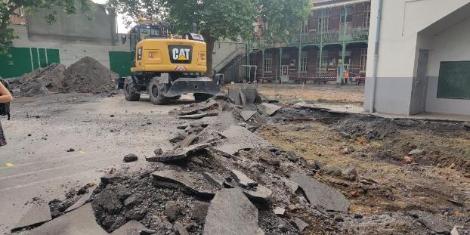Lille (59): schoolyards cleared of vegetation
Le Magazine Du Centre National De La Fonction Publique Territoriale – N° 44 – Juin 2021
June 2021
Centre National de la Fonction Publique Territoriale (CNFPT)
Less concrete and more green spaces. As part of its climate plan, the City of Lille is conducting a vast programme of greening in schools. The project has been led by the city by taking into account the opinion of the first interested parties - the children - and by engaging in a lot of educational work with the parents. In addition to the plants planted, educational gardens, composters, water collection points, sustainable outdoor furniture and games, birdhouses, insect hotels and bat boxes have been installed.
To download : service_public_territorial_juin_2021_numero_44.pdf (980 KiB)

One third of the surface area is planted, one third is mineralized, and one third is mixed… This is the cocktail that the city of Lille has chosen for its program to green its 79 schoolyards. We can see the end of it: by the start of the school year in 2021, 100% of the schoolyards will have been greened. The project goes beyond greening. The transformation of the school grounds has two other objectives: to rethink the space in order to encourage free and non-gendered play, and to involve the children in the development of the future school grounds. « Vegetation is used to serve our project for a city at the level of the child », summarises Charlotte Brun, 3rd deputy mayor in charge of the city of education and the city at the level of the child. To support the transformation of the courtyards, the city relies on the association Récréations Urbaines, created by Céline Lecas, an urban planner specialising in citizen participation, and Clémentine Delval, an architect. Their mission? To carry out a diagnosis of the courtyards and a development project with the children. « The idea is that the children should enjoy a diversified range of games, that everyone should find their place according to their mood in differentiated areas. They should be able to run, jump, dance, observe plants and animals, etc.", explains Clémentine Delval. The children give ideas, imagine small shared gardens, woven wicker huts, a rain garden. Often, they go as far as the final model and their drawings, reinterpreted by the landscape architects, are used for the layout. « They are full of common sense and solutions. For example, in a very small courtyard, they came up with the idea of limiting ball games to one day a week to free up the space for other activities, » says Clémentine Delval.
« This approach also requires a bit of education for the adults. In a planted courtyard, you get dirtier. At the beginning, this can destabilise families. »
Clémentine Delval, Architect.
-
Context:
The municipality’s wish to de-vegetate schoolyards to make them more resilient, and to involve children in development projects that concern them.
-
Initiative:
Revegetation of the 79 schoolyards in the city and consultation with the children during the transformation of their schoolyard.